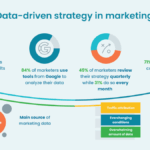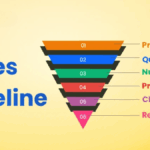Introduction
In the modern business landscape, where competition is fierce and customer attention spans are short, mastering the art of lead tracking has become crucial. Businesses that excel at tracking and nurturing their leads stand a much better chance of turning prospects into paying customers. Lead tracking is not just about knowing who is interested; it’s about understanding behaviors, anticipating needs, and responding with precision and timeliness.
This article explores what lead tracking is, why it matters, how to implement it effectively, and how it ultimately boosts sales conversion rates.
1. Understanding Lead Tracking
Lead tracking refers to the process of monitoring and managing potential customers (leads) throughout their journey in the sales funnel—from first contact to final purchase. It involves collecting data on a lead’s interactions with your business, such as website visits, email opens, downloads, inquiries, and social media engagement.
By analyzing this data, businesses can gauge where a lead is in the buying process, what they’re interested in, and how likely they are to convert.
2. The Importance of Lead Tracking
Tracking leads brings several business benefits, including:
- Improved Conversion Rates: Understanding each lead’s behavior helps sales teams engage at the right time with the right message.
- Shorter Sales Cycles: Identifying hot leads and prioritizing them can accelerate the conversion process.
- Enhanced Personalization: Lead tracking allows tailored communication based on individual preferences and actions.
- Better Resource Allocation: Focus efforts on leads that are most likely to convert, improving sales team efficiency.
- Informed Decision-Making: Data from lead tracking provides insights that guide sales and marketing strategies.
3. Key Elements of Effective Lead Tracking
To implement an effective lead tracking system, consider the following components:
a) Lead Sources
Track where your leads come from—social media, email campaigns, referrals, organic search, or events. Knowing the most effective sources helps focus marketing budgets and efforts.
b) Lead Scoring
Assign scores to leads based on actions like form submissions, email clicks, or product page views. This helps sales teams identify which leads are warm, hot, or cold.
c) Behavioral Tracking
Monitor what pages a lead visits, how long they stay, which emails they interact with, and which offers they respond to. These behavioral cues reveal interests and buying intent.
d) Interaction History
Keep a complete log of communications, meetings, and responses. This history provides context for future conversations and prevents repetition or miscommunication.
e) Lead Status Updates
Update the lead’s status in the funnel regularly (e.g., new, contacted, qualified, proposal sent, won/lost). This keeps the pipeline organized and up to date.
4. How to Implement a Lead Tracking Strategy
a) Define Your Sales Funnel
Start by mapping out your sales funnel stages. This could include awareness, interest, consideration, intent, and purchase. Each stage should have clear criteria for progression.
b) Choose the Right Tools
Use digital tools that support lead tracking functionalities such as contact management, activity tracking, and reporting. Tools should integrate with email, web forms, and marketing channels.
c) Collect the Right Data
Gather both quantitative (e.g., clicks, visits) and qualitative (e.g., inquiries, feedback) data. Ask relevant questions during lead capture to enrich profiles and enable segmentation.
d) Align Sales and Marketing Teams
Ensure both teams work from the same data and definitions. Marketing generates leads, but sales converts them—so alignment is key for consistent lead tracking and follow-up.
e) Establish Follow-Up Protocols
Create automated or manual workflows to follow up with leads at specific points based on their actions. Timely responses can significantly impact conversion likelihood.
f) Analyze and Optimize
Regularly review lead tracking reports to see which strategies yield the highest conversions. Adjust scoring models, messaging, and outreach methods based on performance.
5. Best Practices to Maximize Conversions
a) Segment Leads
Group leads by behavior, interests, or demographics. Targeted communication increases relevance and engagement.
b) Nurture Leads with Content
Provide value through emails, newsletters, videos, and downloadable resources that guide leads along their decision-making path.
c) Prioritize High-Intent Leads
Leads showing repeated engagement or high-value actions (e.g., pricing page visits, demo requests) should be acted upon promptly.
d) Maintain Consistent Communication
Don’t let leads go cold. Stay in touch with regular, non-intrusive check-ins and updates.
e) Use Data to Personalize Outreach
Mention specific actions or interests in your outreach messages. A personal touch often moves the needle toward conversion.
6. Measuring the Impact of Lead Tracking
To determine the success of your lead tracking strategy, monitor the following metrics:
- Lead-to-Customer Conversion Rate
- Time to Conversion
- Sales Cycle Length
- Lead Source Effectiveness
- Lead Engagement Score
Regular performance reviews help refine tactics, optimize campaigns, and increase ROI from lead generation efforts.
Conclusion
Mastering lead tracking is not a one-time effort; it’s an ongoing process of refining how your business captures, analyzes, and acts on customer interest. By understanding where leads come from, how they behave, and what they need, you can significantly improve your chances of converting them into long-term customers.
In a world where customer attention is fragmented and competition is high, a strong lead tracking system gives your business the edge it needs to grow with confidence and clarity.
Frequently Asked Questions (FAQs)
Q1: What is the difference between a lead and a prospect?
A: A lead is someone who has shown initial interest in your business, while a prospect is a qualified lead that fits your target audience and shows potential to become a customer.
Q2: How can small businesses implement lead tracking without expensive tools?
A: Start with simple spreadsheets or free versions of digital tools. Consistency in recording lead data and follow-ups is more important than complexity.
Q3: How often should lead data be updated?
A: Ideally, update lead data in real-time or at least daily to ensure sales teams have the most current information for outreach.
Q4: What actions typically indicate a hot lead?
A: Actions such as requesting a quote, booking a demo, visiting pricing pages multiple times, or replying to sales emails are signs of a high-intent lead.
Q5: Can lead tracking help reduce the sales cycle?
A: Yes. By identifying and acting on signals of buyer readiness, lead tracking helps prioritize leads that are close to a decision, reducing the time to conversion.


